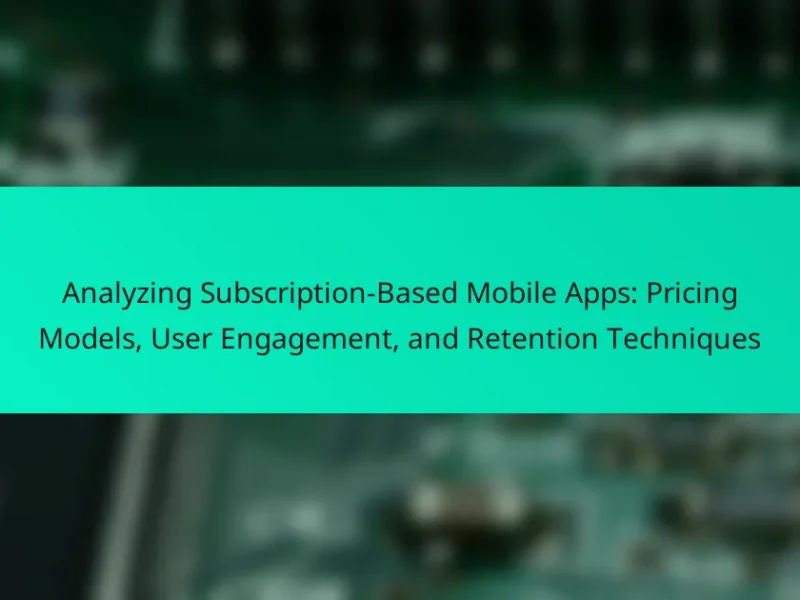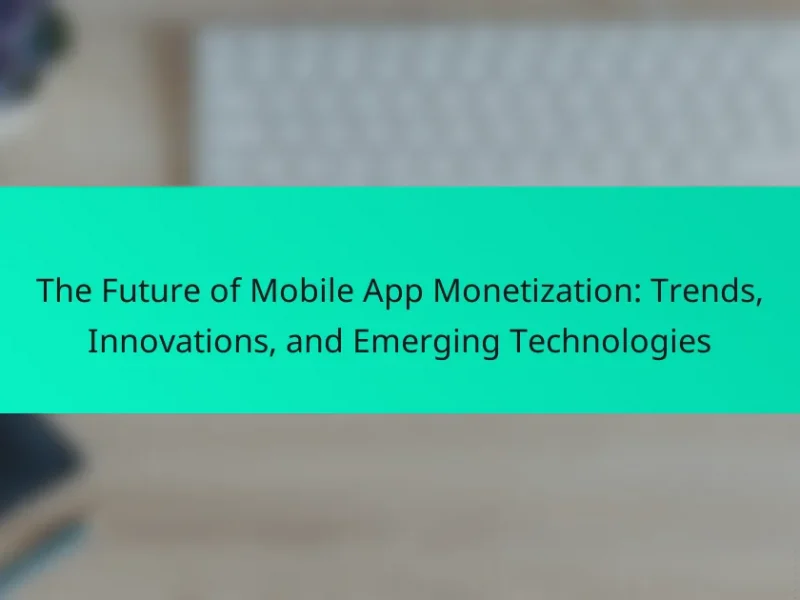Crowdfunding for mobile app development is a funding strategy that involves raising capital through small contributions from a large audience. This approach enables developers to secure financial backing before the app’s launch, with platforms like Kickstarter and Indiegogo playing a crucial role in connecting them with potential supporters. The article highlights successful case studies, such as Pebble and Ouya, which exemplify the effectiveness of crowdfunding in the tech sector, where over $1 billion was generated in 2020 alone. It also discusses various funding strategies, including bootstrapping and angel investors, emphasizing the growing viability of crowdfunding as a means to finance mobile app projects.
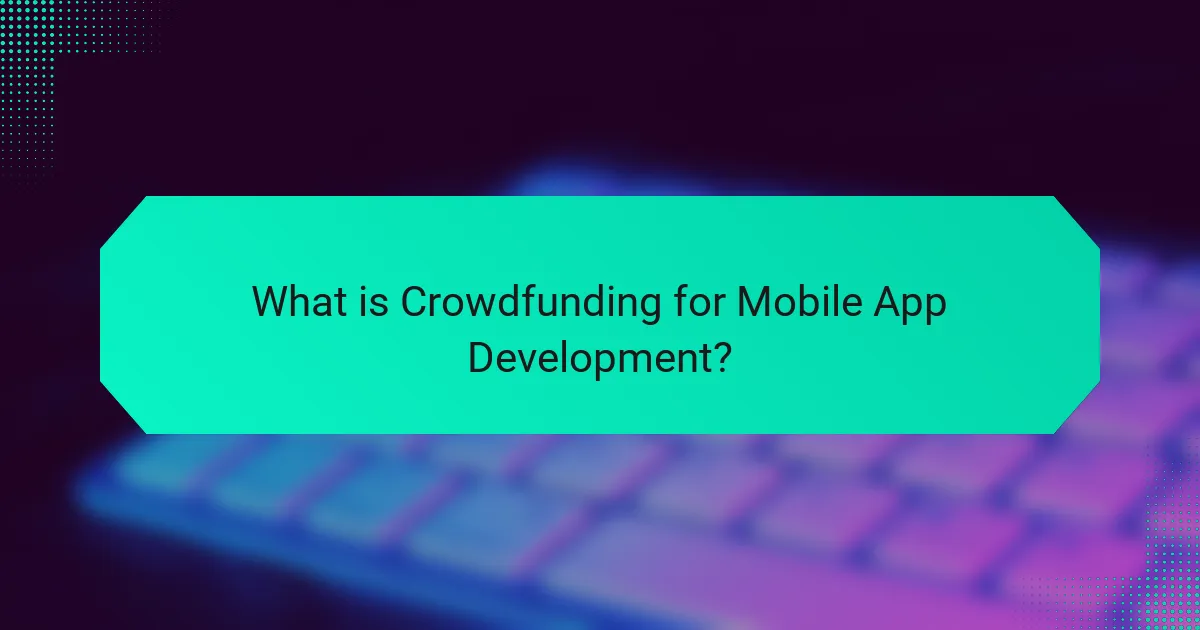
What is Crowdfunding for Mobile App Development?
Crowdfunding for mobile app development is a method of raising funds through small contributions from a large number of people. This approach allows developers to gather financial support before launching their app. Platforms like Kickstarter and Indiegogo facilitate this process by connecting creators with potential backers. Successful crowdfunding campaigns can validate app ideas and build an initial user base. According to a 2020 report by Statista, crowdfunding in the tech sector, including mobile apps, generated over $1 billion in funding. This method empowers developers to retain control over their projects while minimizing financial risk.
How does crowdfunding work in the context of mobile app development?
Crowdfunding for mobile app development involves raising funds from a large number of people, typically via online platforms. Developers present their app ideas on crowdfunding sites like Kickstarter or Indiegogo. They set a funding goal and a deadline for contributions. Backers can pledge money in exchange for rewards, such as early access or exclusive features. If the funding goal is met, the developers receive the funds to create the app. If not, backers are not charged. This model allows developers to validate their ideas and build a community before launch. Successful campaigns can generate significant financial support and market interest. For example, the app Pebble raised over $10 million on Kickstarter, showcasing crowdfunding’s potential in this field.
What are the key stages of a crowdfunding campaign for mobile apps?
The key stages of a crowdfunding campaign for mobile apps include planning, launching, and managing. During the planning stage, developers define their app concept and target audience. They create a compelling pitch that outlines the app’s features and benefits. This stage also involves setting a funding goal and timeline.
The launching stage involves promoting the campaign across various platforms. Developers utilize social media, email marketing, and press releases to generate interest. Engaging visuals and videos can enhance the campaign’s appeal.
The managing stage focuses on maintaining momentum throughout the campaign. Regular updates keep backers informed and engaged. Responding to questions and feedback is crucial for building trust.
Successful campaigns often see a boost in funding during the final days. This is due to increased urgency and last-minute contributions. Overall, these stages are essential for a successful crowdfunding campaign for mobile apps.
How do backers contribute to mobile app projects through crowdfunding?
Backers contribute to mobile app projects through crowdfunding by providing financial support. They pledge money to projects they find appealing. This funding helps developers cover initial costs like design and marketing. In return, backers often receive rewards, such as early access to the app or exclusive features. Crowdfunding platforms facilitate this interaction, allowing developers to present their ideas to a broad audience. Successful campaigns can attract thousands of backers, significantly impacting the project’s viability. For instance, a study by the University of Cambridge found that crowdfunding can lead to higher success rates for mobile app launches.
What are the different types of crowdfunding platforms available?
There are several types of crowdfunding platforms available. These include donation-based crowdfunding, where contributors give without expecting returns. Reward-based crowdfunding allows backers to receive non-financial rewards. Equity crowdfunding lets investors gain shares in a company in exchange for their funds. Debt crowdfunding involves loans that are repaid with interest. Real estate crowdfunding allows individuals to invest in property projects. Each type serves different funding needs and target audiences. According to Statista, the global crowdfunding market was valued at approximately $13.9 billion in 2021, illustrating its growing significance.
What are the major crowdfunding models for mobile app development?
The major crowdfunding models for mobile app development include rewards-based, equity-based, and donation-based crowdfunding. Rewards-based crowdfunding allows backers to receive non-financial rewards, such as early access to the app or exclusive features. Platforms like Kickstarter and Indiegogo primarily operate on this model. Equity-based crowdfunding enables backers to invest in the app and receive equity shares. This model is facilitated by platforms like SeedInvest and Crowdcube. Donation-based crowdfunding involves individuals contributing funds without expecting anything in return, often used for charitable or community-driven projects. Each model serves different funding needs and target audiences, providing diverse options for app developers.
How do reward-based platforms differ from equity-based platforms?
Reward-based platforms provide backers with non-financial rewards for their contributions. These rewards can include products, services, or experiences related to the project. In contrast, equity-based platforms allow backers to invest in a company in exchange for ownership shares. This means backers can receive financial returns based on the company’s performance.
The key difference lies in the nature of the return on investment. Reward-based platforms focus on tangible rewards, while equity-based platforms emphasize financial stakes in the business. For example, Kickstarter is a prominent reward-based platform, where backers receive a product or experience. On the other hand, platforms like SeedInvest offer equity stakes in startups.
This distinction is crucial for entrepreneurs when choosing a crowdfunding strategy. Understanding the differences helps in aligning funding approaches with business goals.
What are the benefits of using crowdfunding for mobile app development?
Crowdfunding provides multiple benefits for mobile app development. It allows developers to raise funds without traditional financing. This approach minimizes financial risk by securing funds before development begins. Additionally, crowdfunding helps gauge market interest in an app concept. Engaging potential users during the campaign can foster a community around the app. Successful campaigns often provide valuable feedback that can refine the app’s features. Furthermore, platforms like Kickstarter and Indiegogo offer exposure to a broad audience. This visibility can attract early adopters and potential investors. Ultimately, crowdfunding can validate an idea while providing necessary capital for development.
How can crowdfunding help validate an app idea before development?
Crowdfunding can help validate an app idea before development by gauging market interest and securing initial funding. When a crowdfunding campaign is launched, potential backers express their interest through financial contributions. This immediate feedback indicates whether the app concept resonates with the target audience. Successful campaigns often demonstrate that there is a demand for the app. For instance, a study by the University of Pennsylvania found that 40% of crowdfunding projects reach their funding goals, reflecting strong market validation. Additionally, backers often provide valuable feedback that can refine the app’s features. This process reduces the risk of investing in an idea with low market interest. Thus, crowdfunding serves as both a funding mechanism and a validation tool for app developers.
What financial advantages does crowdfunding offer to developers?
Crowdfunding offers developers several financial advantages. It provides access to capital without incurring debt. Developers can secure funding from a diverse pool of backers. This reduces reliance on traditional investors or loans. Crowdfunding also allows developers to validate their ideas before full-scale production. Successful campaigns can create a community of early adopters. These backers often contribute not just funds but also feedback. According to a 2020 study by the University of Cambridge, 38% of crowdfunding projects meet their funding goals. This statistic highlights the potential success rate for developers using crowdfunding.
How can developers successfully launch a crowdfunding campaign?
Developers can successfully launch a crowdfunding campaign by thoroughly planning their project and engaging potential backers. Clear communication of the project’s goals and benefits is essential. Developers should create an appealing campaign page with high-quality visuals and a compelling video. Establishing a realistic funding goal based on project costs enhances credibility. Developers must promote their campaign through social media and email outreach to build an audience. Regular updates during the campaign keep backers informed and engaged. According to a study by Kickstarter, campaigns with updates receive 4 times more backers than those without. Engaging with the community fosters trust and encourages support.
What strategies can be employed to create an engaging campaign page?
To create an engaging campaign page, use compelling visuals and concise messaging. High-quality images and videos attract attention and convey your app’s value. Clear, engaging headlines summarize your campaign’s purpose and benefits. A well-structured layout guides visitors through your content seamlessly. Include a strong call-to-action that encourages support or sharing. Social proof, such as testimonials or endorsements, builds trust and credibility. Regular updates keep backers informed and engaged throughout the campaign. According to a study by Indiegogo, campaigns with videos raise 9% more funds than those without.
How important is marketing in promoting a crowdfunding campaign?
Marketing is crucial in promoting a crowdfunding campaign. Effective marketing strategies can significantly increase visibility and attract potential backers. Research indicates that campaigns with strong marketing efforts raise 50% more funds on average. Utilizing social media, email marketing, and influencer partnerships enhances outreach. A well-executed marketing plan can create a sense of urgency and community around the project. Campaigns that engage their audience tend to achieve higher funding goals. Therefore, marketing is not just important; it is essential for crowdfunding success.
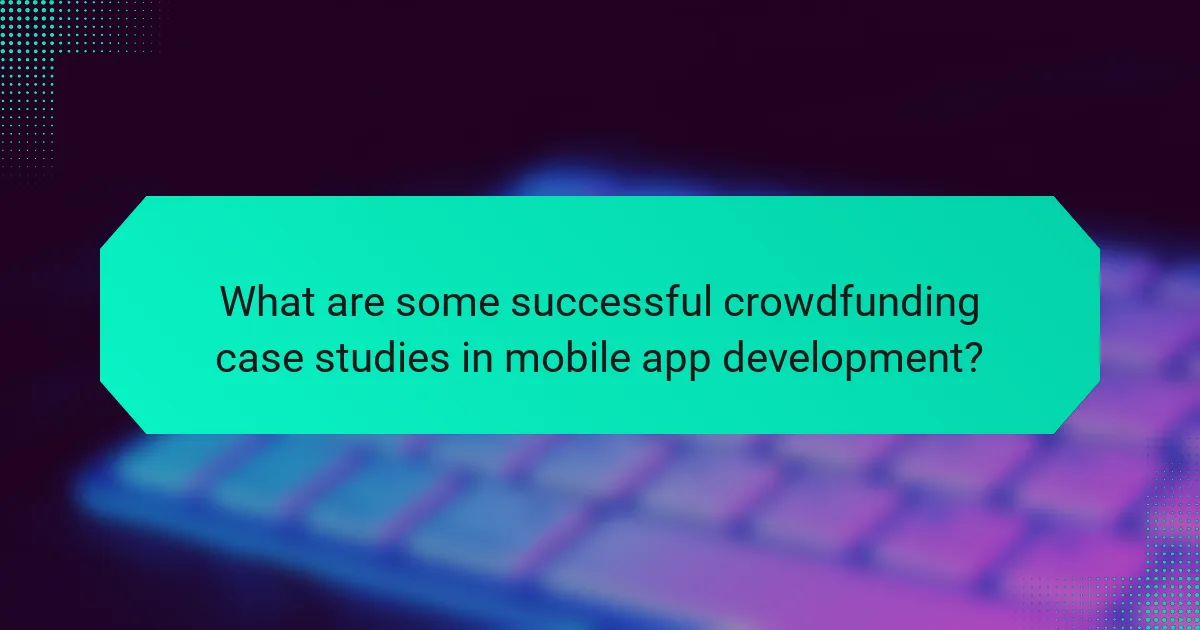
What are some successful crowdfunding case studies in mobile app development?
Successful crowdfunding case studies in mobile app development include notable projects like Pebble, the smartwatch app. Pebble raised over $10 million on Kickstarter in 2012. Another example is the game app, Ouya, which raised $8.6 million on Kickstarter in 2012. The app, Elevate, focused on brain training and raised $1.5 million on Kickstarter. These projects demonstrate the potential of crowdfunding in securing substantial financial support for mobile app development.
What lessons can be learned from successful crowdfunding campaigns?
Successful crowdfunding campaigns demonstrate the importance of clear communication and engaging storytelling. They effectively convey the project’s vision and value proposition. A well-defined target audience enhances campaign success. Campaigns that actively engage with backers build a loyal community. Offering attractive rewards motivates contributions. Setting realistic funding goals is crucial for maintaining momentum. Regular updates keep backers informed and invested. Utilizing social media amplifies reach and visibility. These strategies are supported by successful examples like Pebble Technology, which raised over $10 million through effective storytelling and community engagement.
How did specific apps achieve funding goals through unique strategies?
Specific apps achieved funding goals through unique strategies by leveraging targeted marketing and community engagement. For instance, the app “Pebble” utilized a strong social media presence to build a dedicated following before launching its Kickstarter campaign. This approach resulted in raising over $10 million, far exceeding its initial goal of $100,000.
Another example is “Exploding Kittens,” which employed humor and engaging visuals in its campaign. This strategy resonated with potential backers, leading to over $8.7 million raised against a goal of $10,000.
Additionally, apps like “Oculus Rift” offered early backers exclusive rewards, creating urgency and incentivizing contributions. This tactic helped Oculus raise nearly $2.5 million, significantly surpassing its $250,000 target.
These unique strategies highlight the importance of community involvement, effective communication, and appealing incentives in achieving funding goals.
What common traits do successful crowdfunding projects share?
Successful crowdfunding projects typically share strong communication, a clear value proposition, and effective marketing strategies. Strong communication fosters trust and engagement with backers. A clear value proposition articulates the project’s unique benefits and goals. Effective marketing strategies include leveraging social media and email campaigns to reach a broader audience. Research shows that projects with engaging videos raise 9% more funds than those without. Additionally, projects that update backers regularly tend to achieve higher success rates. These traits contribute to building a loyal supporter base and increasing funding potential.
What challenges do developers face when crowdfunding mobile apps?
Developers face several challenges when crowdfunding mobile apps. One major challenge is competition for attention among numerous projects. Many crowdfunding platforms host thousands of campaigns, making it difficult for individual projects to stand out. Additionally, developers often struggle with creating a compelling pitch. A clear and engaging presentation is crucial for attracting backers.
Another challenge is setting realistic funding goals. Developers must balance the need for sufficient funds with the risk of appearing unachievable. Moreover, managing backer expectations can be difficult. Developers need to communicate progress and setbacks effectively throughout the campaign.
Marketing is also a significant hurdle. Many developers lack experience in promoting their projects to a wide audience. This can limit their reach and funding potential. Finally, fulfilling rewards can pose logistical challenges. Developers must ensure they can deliver on promises made during the campaign. These challenges can hinder the success of crowdfunding efforts for mobile apps.
How can developers overcome common obstacles in crowdfunding?
Developers can overcome common obstacles in crowdfunding by conducting thorough market research. This helps identify target audiences and their preferences. Clear communication of project goals is essential to attract backers. Providing regular updates maintains engagement with potential supporters. Developers should also create compelling visuals and prototypes to showcase their ideas effectively. Setting realistic funding goals increases the likelihood of success. Additionally, leveraging social media for outreach can significantly expand the project’s visibility. According to a study by Kickstarter, projects with a clear narrative and strong visuals raise 50% more funding than those without.
What are the risks associated with crowdfunding for mobile apps?
Crowdfunding for mobile apps carries several risks. One significant risk is the potential for project failure. Many mobile app projects do not meet their funding goals or fail to deliver a viable product. According to a study by the University of Pennsylvania, about 57% of crowdfunding campaigns do not reach their funding targets. Another risk involves mismanagement of funds. Developers may misallocate the funds raised, leading to project delays or subpar app quality. Legal issues can also arise, including intellectual property disputes or failure to meet regulatory requirements. Additionally, backers may face the risk of not receiving promised rewards if the project fails. Market competition is another concern, as a crowded app market can diminish the chances of success for newly launched apps. Finally, reputational damage can occur if a project fails, impacting future fundraising efforts.
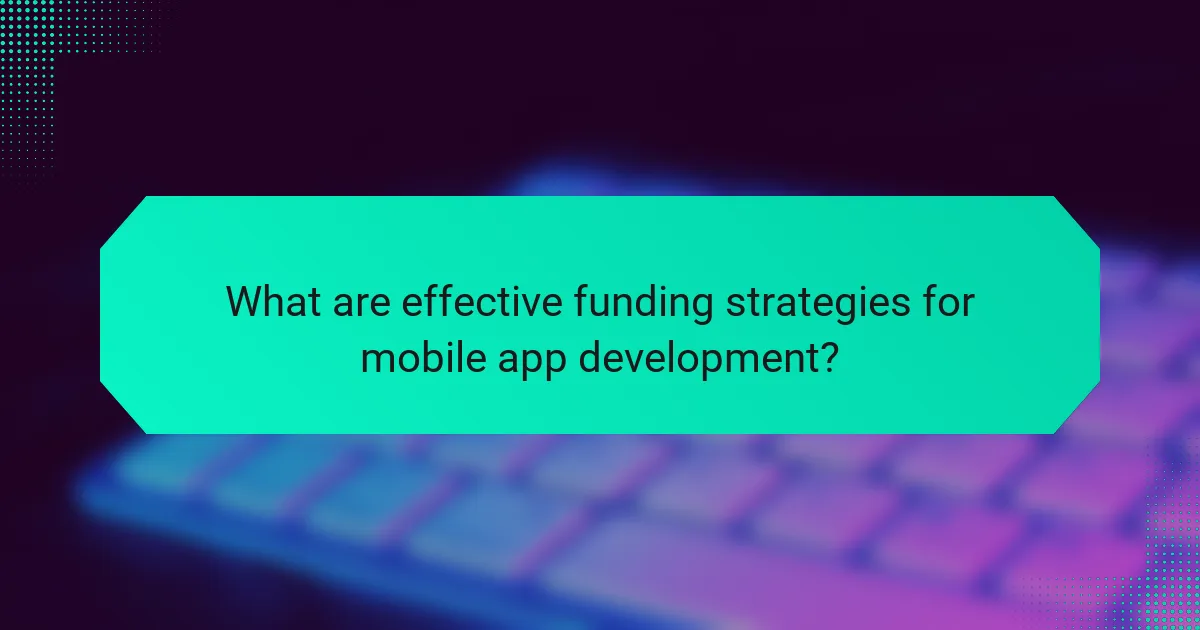
What are effective funding strategies for mobile app development?
Effective funding strategies for mobile app development include bootstrapping, seeking angel investors, and utilizing crowdfunding platforms. Bootstrapping allows developers to self-fund their projects through personal savings or revenue from other ventures. Angel investors provide capital in exchange for equity, often bringing valuable industry connections. Crowdfunding platforms like Kickstarter and Indiegogo enable developers to raise funds directly from potential users. According to a study by the University of Cambridge, 44% of successful crowdfunding projects were mobile apps. This demonstrates the viability of crowdfunding as a strategy for funding app development.
How can developers set realistic funding goals for their campaigns?
Developers can set realistic funding goals by assessing project costs and market demand. They should calculate all expenses, including development, marketing, and operational costs. Researching similar campaigns provides insights into funding benchmarks. Analyzing target audience size helps gauge potential backer interest. Setting a funding goal that covers at least 70% of total costs is advisable. This approach increases the likelihood of campaign success. According to a study by Kickstarter, campaigns with clear funding goals are 36% more likely to reach their target.
What factors should be considered when determining funding amounts?
Key factors to consider when determining funding amounts include project scope, target audience, and development costs. Project scope defines the features and functionalities required, influencing the overall budget. Target audience assessment helps identify potential backers and their willingness to contribute. Development costs encompass expenses such as design, programming, marketing, and ongoing support. Additionally, market research can provide insights into similar projects and their funding success, guiding the amount sought. Financial projections and timelines are also critical, as they outline expected returns and project duration, impacting funding requests. Each of these factors contributes to a well-rounded funding strategy, ensuring realistic and achievable goals.
What role does community engagement play in crowdfunding success?
Community engagement is crucial for crowdfunding success. Engaged communities provide financial support and amplify project visibility. They create a sense of trust and loyalty towards the project. This engagement often translates to higher funding amounts. According to a study by the University of Cambridge, projects with strong community backing raise 50% more funds on average. Additionally, active community members often share the project within their networks. This organic promotion leads to increased reach and potential backers. Overall, community engagement fosters a supportive environment that is essential for successful crowdfunding campaigns.
How can developers build a loyal community around their app before launching a campaign?
Developers can build a loyal community around their app by engaging potential users early. They should create social media accounts dedicated to the app. Regularly sharing updates and behind-the-scenes content fosters interest. Developers can also establish a website or blog to provide detailed information. Offering exclusive content or early access to features can incentivize sign-ups. Hosting webinars or Q&A sessions allows for direct interaction with potential users. Collaborating with influencers in the app’s niche can amplify reach. Gathering feedback through surveys or beta testing helps refine the app and builds trust. These strategies have proven effective in creating engaged communities prior to launch.
What are the best practices for post-campaign engagement with backers?
Best practices for post-campaign engagement with backers include regular updates, personalized communication, and fulfilling promises. Regular updates keep backers informed about project progress. Personalized communication fosters a stronger connection with backers. Fulfilling promises builds trust and credibility. Additionally, expressing gratitude can enhance backer loyalty. Engaging backers on social media can maintain interest and excitement. Offering exclusive content or rewards can incentivize continued support. Surveys can gather feedback for future improvements. These practices enhance backer relationships and can lead to future funding opportunities.
How should developers communicate updates and progress to their backers?
Developers should communicate updates and progress to their backers through regular, transparent, and concise updates. This includes utilizing platforms such as email newsletters, project websites, and social media channels. Frequent updates keep backers informed and engaged. Developers should detail milestones achieved and future plans. Visual aids like screenshots or videos enhance understanding. Responding to backer inquiries fosters community trust. According to a study by the University of Pennsylvania, consistent communication can increase backer satisfaction and retention.
What steps can be taken to maintain backer interest after funding is achieved?
To maintain backer interest after funding is achieved, consistent communication is essential. Regular updates on project progress keep backers engaged. Sharing milestones and achievements fosters a sense of involvement. Transparency about challenges and setbacks builds trust. Offering exclusive insights or behind-the-scenes content enhances connection. Engaging backers through surveys or feedback requests shows their opinions are valued. Providing rewards or bonuses for early supporters can incentivize ongoing interest. Lastly, creating a community around the project encourages backers to stay connected and invested.
What tips can help ensure a successful crowdfunding experience?
To ensure a successful crowdfunding experience, create a compelling campaign narrative. A strong story engages potential backers and clarifies your project’s purpose. Clearly outline your funding goals and how the money will be used. Transparency builds trust with your audience. Offer attractive rewards that incentivize contributions. Unique rewards can motivate higher pledges. Promote your campaign across multiple platforms to reach a wider audience. Utilize social media, email, and press releases for maximum visibility. Engage with backers regularly to maintain interest and provide updates. Consistent communication fosters community and encourages ongoing support. Lastly, set a realistic funding target based on thorough market research. According to a study by the University of Cambridge, campaigns with clear goals are 30% more likely to succeed.
Crowdfunding for mobile app development is a fundraising method that enables developers to secure financial support from a large number of backers through platforms like Kickstarter and Indiegogo. This article explores various aspects of crowdfunding, including its operational mechanisms, key stages of campaigns, types of platforms, and funding models. It highlights successful case studies, the benefits of community engagement, and effective strategies for launching and managing crowdfunding campaigns. Additionally, the article addresses challenges developers may face and offers best practices for maintaining backer interest post-campaign.

